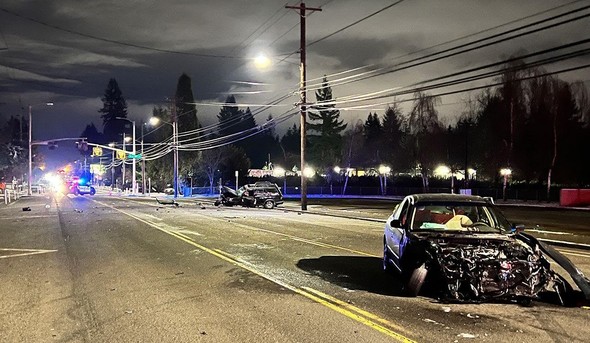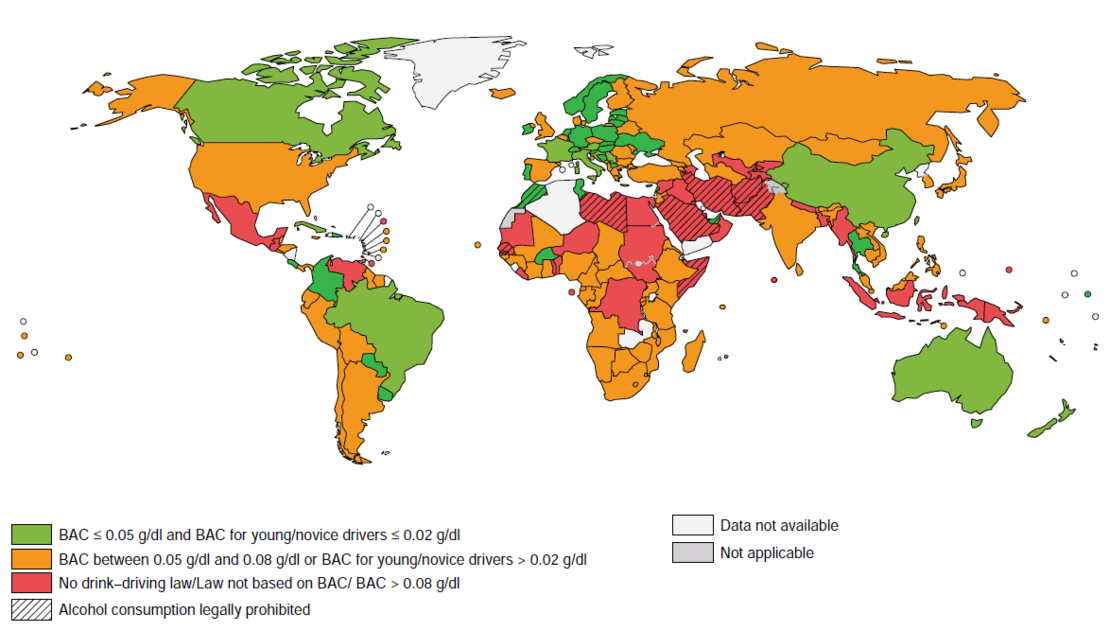 News media contact:
Dylan Rivera
Cell: 503-577-7534
dylan.rivera@portlandoregon.gov
@pbotinfo
News Blog:
Alcohol remains a major factor in deadly Portland crashes
If you drink, it is safest to avoid driving and to help others do the same.
 An alleged DUII driver collided head-on with a person in another vehicle on NE Glisan Street near 152nd Avenue in December, 2021, resulting in serious injuries. Photo courtesy of the Portland Police Bureau.
(March 4, 2022) In Portland we are rightly proud of our local breweries, wineries, and distilleries.
But we should not be proud of continued serious crashes involving alcohol. At least 43 people died in 2020 and 2021 from crashes in which the Portland Police Bureau believe alcohol may have been a factor. This number will likely increase as crash data is finalized.
More than one-in-three Portland traffic deaths involved alcohol impairment from 2015 through 2019, the latest five-year period for which complete data is available (see chart and map). An additional 198 people suffered serious injuries, such as brain damage or paralysis, due to alcohol-involved crashes during the same period.
 The proportion of deadly Portland crashes involving alcohol impairment is consistently high. (Final data for 2020 and 2021 is not yet available.) Data: Oregon Department of Transportation.
National data suggest the role of alcohol in crashes has increased during the Covid-19 pandemic. Greater proportions of serious and deadly crashes appear to involve alcohol impairment, including by people driving, on motorcycles, and pedestrians.
Already this year, a person has been charged with driving under the influence of intoxicants in a crash that killed 34-year-old Salvador Manuel Rodriguez-Lopez, who was driving on Interstate 5 when he collided head-on with an alleged DUII driver traveling the wrong direction on Tuesday, Jan. 4, around 11 p.m.
Other recent crashes include:
- On Saturday, Jan. 22, 2022, at 12:40 a.m., an alleged DUII driver collided with five people in another vehicle on SE Bybee Boulevard at 23rd Avenue, injuring five people, two of them seriously.
- On Wednesday, Dec. 29, 2021, an alleged DUII driver collided head-on with a person in another vehicle on NE Glisan Street near 152nd Avenue, at 5:20 p.m., resulting in “severe head and body trauma” to the alleged impaired driver.
- On Sunday, Dec. 5, 2021, at 3:20 a.m., an alleged DUII driver on Interstate 205 near Powell Boulevard departed the roadway and struck a person living nearby, killing them.
Drinking alcohol and then driving sharply increases the risk of killing or seriously injuring yourself or others. Odds of crashing double even below Oregon’s legal blood alcohol content (BAC) limit of 0.08. (People below 0.08 can still face DUII charges if they fail field sobriety tests.)
People not hurt in a crash may still face license suspension, job loss, higher insurance costs, court fees, or jail time. Crash survivors may also face depression or other mental health issues.
While substances other than alcohol can also increase the risk of crashing, research indicates that alcohol has the biggest impact on deadly crash risk.
 Click the image to view the interactive map. More than one-third of Portland traffic deaths involved alcohol impairment (shown as orange triangles) from 2015 through 2019. Final data is not yet available for 2020-21. Source: Oregon Department of Transportation
How many drinks are safe before driving?
It is best to avoid driving after drinking alcohol. Even one drink can make it harder for people to visually track moving targets and to perform two tasks at the same time, both of which are important for driving. By the time a person hits Oregon’s legal BAC limit they are three times more likely to crash compared to a sober person.
Translating a specific number of drinks into BAC levels is difficult. BAC for a given number of drinks depends on factors including height, weight, gender, a person’s liver function, and the strength of the drinks.
The effects of even low levels of alcohol on driving have led Utah and many countries to adopt BAC limits lower than 0.08. A recent study concludes that Utah’s 0.05 limit has likely reduced crashes while not resulting in any additional DUII arrests. Countries including Brazil have made it illegal to have any measurable alcohol in the blood of people driving (see map). The World Health Organization recommends legal limits no higher than 0.05 for the general population and no higher than 0.02 for “young and novice” drivers. In 2019, Oregon legislators considered but did not pass a bill to lower Oregon’s legal BAC limit to 0.05.
 Countries meeting World Health Organization ”best practice” for drinking and driving (green color). Graphic courtesy World Health Organization.
How you can help
-
Avoid driving after drinking any amount of alcohol. Public transit, taxis, ridehailing services, and designated drivers are good alternatives to driving impaired.
-
If you are drinking with a group, help others travel in ways other than driving themselves. Intervening to prevent others from driving after drinking can be a powerful way to prevent serious crashes.
-
Overnight parking is allowed at most public SmartPark garages and on many Portland streets. A parking ticket is also much cheaper than a crash.
-
Parents and guardians can help their children make safe choices by teaching them not to drink and drive or to ride with anyone who has been drinking.
Thank you for helping Portland meet our Vision Zero goal to eliminate traffic deaths and serious injuries.
###
The Portland Bureau of Transportation (PBOT) is the steward of the City’s transportation system, and a community partner in shaping a livable city. We plan, build, manage and maintain an effective and safe transportation system that provides access and mobility. Learn more at www.portlandoregon.gov/transportation
|